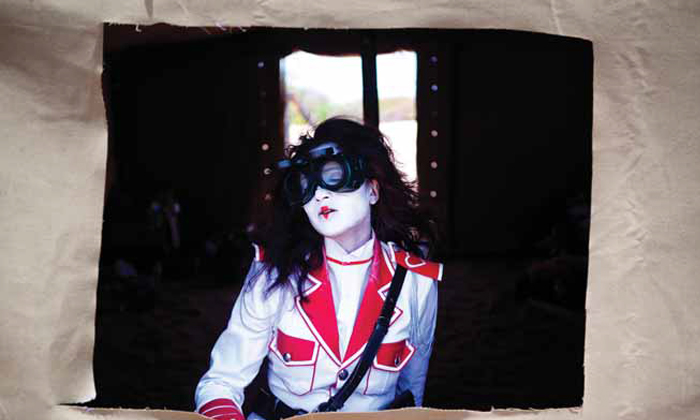There are two sets of people in Calcutta – those who have watched Gandu and those who haven’t. For those who have, its director Q is the mascot of evolving Bengali Cinema who took Gandu to film festivals pan continents. And for those who haven’t, Q has laid a new deck of cards on the table, Tasher Desh, representing the larger independent cinema scene in India taking it to theatres. Tasher Desh, meaning Land of Cards, is an adaptation of Rabindranath Tagore’s experimental dance drama of the same name. An audio-visual treat on celluloid, this movie is set in a fantasy land with soldiers dressed in red, black and white uniforms and card symbols – clubs, diamonds, hearts and spades – painted on their lips. The anti fascist metanarrative of the movie can be juxtaposed with independent cinema’s struggle in the country.
Tasher Desh has Manu Dacosse, a Belgian cinematographer shoot a palette of bold colours, unlike Gandu’s atmospheric black and white, in Sri Lanka and India. Q has used staccato film editing for his non-linear plot, split-screen shots and his patent over-use of hand-held cameras for the three narratives running parallel to each other. Designed in a graphic novel format, he says the music and costumes play a major role in cultivating the innermost spirit in his movie.
The storyline is integrated with 18 different soundtracks – all Rabindra Sangeet, but of course with Q’s eccentric flavour. Neel Adhikary, the music producer has maintained Tagore’s lyrical words in each soundtrack and has instead played with the rhythm and chords to make a contemporary neo-Rabindra Sangeet mix. He says, “Rabindra Sangeet has never been pushed so far, till date. This is the beginning of the new, in tandem with the audacious movie narrative.” The music for Tasher Desh is not restricted by any genre, much like every other aspect of the movie. All 18 tracks are hybrid in their form where the indigenous has been fused with folk, rock, electronic and drum-bass effects to name a few, producing an eclectic mix befitting the post-modernist set up of the film. Q says, “The story is about taking a leap, a fantasy liberation – which is metaphorical to art today. Even the music therefore is about the leap we have taken in producing Rabindra Sangeet differently.”
“Contemporary form of Rabindra Sangeet, an Alice In Wonderland inspired get up, state of the art cinematography and complementing costumes make Tagore’s work through Q’s lens an intriguing project to look forward to.“
The most unique part of the movie’s soundtrack is the fact that it is a collaborative effort of artistes from 25 different countries. Where on one hand there are artistes such as Steve Chandra Savale of Asian Dub Foundation – a British electronic band, Sam Mills a unique guitarist and jazz great Erik Truffaz, on another there are the likes of Susheela Raman, internationally renowned percussionist Tanmoy Bose and Anusheh Anadil from Bangladesh. Miti Adhikary, who has mixed for legendary bands such as Coldplay and Foo Fighters has co-produced Tasher Desh’s varied Rabindra Sangeet tracks with Neel Adhikary. When asked about Susheela Raman singing Gopono kothati for the film, Q says, “I had heard her sing in different languages – Tamil, Hindi, Kannada and the ethereal tone of her voice was exactly what I wanted for the character Patralekha. The vibe she brings with every language is fascinating. I actually never thought she would say yes to a Rabindra Sangeet for my movie.” Susheela Raman herself took it as a challenge and was quoted saying, “I picked up the song phonetically first to get the accent right. Yet, the fact that there’s a clipped-ness about my accent gave the song its X-factor.”
Tasher Desh, an August release, is similar to Q’s previous film Gandu in terms of the broader aesthetics and most of the cast and crew. But it is part of the new league of independent cinema which are experimental yet backed by producers. Co-producers NFDC, Overdose Joint, Anurag Kashyap Films Pvt Ltd, Dream Digital Inc and Entre Chien et Loup (Belgium) have shown support for this film. Q says, “Nothing will stop me from experimenting with form and technique. I made Gandu with a limited budget. The difference is that in India people invest in cinema as business whereas in Europe cinema is looked at as culture, not an industry. That viewpoint has to change in India for the benefit of independent cinema.”
Independent filmmakers are making offbeat films with a post-structuralism fervour and the audience is reactive and alive to this contemporary wave of cinema. This year, marking the centenary of Hindi cinema, has seen neat examples of independent cinema such as Ship Of Theseus and B.A. Pass so far, where the former had collected Rs 25.89 Lakh in the first week.
Contemporary form of Rabindra Sangeet, an Alice In Wonderland inspired get up, state of the art cinematography and complementing costumes make Tagore’s work through Q’s lens an intriguing project to look forward to. Another feather in the cap of Indian independent cinema, Q shows what Tagore’s work would look like on an acid trip – reasons enough to give this a shot.














